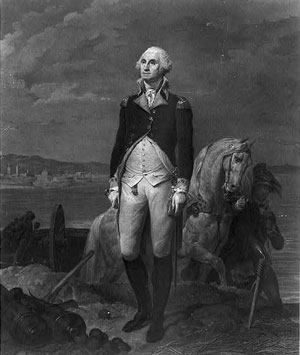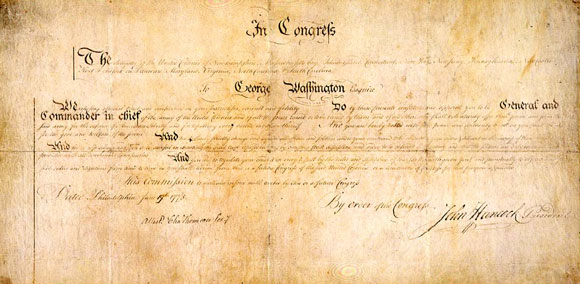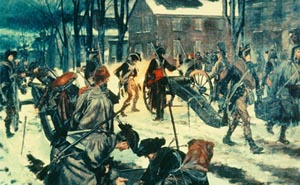 |
|
| War
for Independence The Revolutionary War in North Jersey |
|
| History • American Revolution • Wick House • Dey Mansion • Maps |
George Washington and the Continental Army spent almost half of the Revolutionary War in New Jersey. During the American Revolutionary War, New Jersey was strategically located between the Continental Congress in Philadelphia and the British command center in New York City. From 1775 until 1783, New Jersey was the location of major battles and minor skirmishes that historic homes, battlefield sites and historical monuments bear testament to today. For these reasons New Jersey has become known as the "Crossroads of the American Revolution". Although most battles were fought in southern New Jersey such as at Fort Monmouth, Fort Mercer and Trenton, Northern New Jersey offers many historical sites from this era. Prominent figures in American history who made their way through New Jersey during the war years included Alexander Hamilton, Benedict Arnold, George Washington and Thomas Paine among others. Although patriotic sympathy was evident in 1765 with the burning in effigy of the stamp tax distributor forcing his resignation, by 1777 New Jersey itself fell into civil war splitting into groups of rebels and Loyalists. From the Ramapo Mountains to Cape May, both sides suffered as the lives and properties of thousands was destroyed . The Speaker of the New Jersey Assembly, Cortlandt Skinner, who cast the deciding vote to petition King George for redress of grievances, served the loyalist forces as a Brigadier General. Richard Stockton became the only signer of the Declaration of Independence who also signed a British loyalty oath. Many loyalists fled New Jersey for British controlled New York. There they joined loyalist forces such as Skinner's New Jersey Volunteers. The battalions of New Jerseyans in the British Loyalist forces equalled volunteers in the rebels' Continental Army. On June 15, 1775, the Continental Congress in Philadelphia
officially took responsibility for the improvised army that
was confronting General Gage's British Army regulars in Massachusetts.
The congress unanimously selected George Washington of Virginia
as the nations first "Commander in Chief". One week
later on the 23rd of June, Washington set out accompanied by
four other delegates from the Congress, New York's Philip Schuyler
and New Hampshire's John Sullivan as generals with Thomas Mifflin
and Joseph Reed, both from Pennsylvania, as members of Washington's
personal staff. Washington left with Schuyler, Charles Lee, Horatio Gates, assorted aides and servants, and an escort of militia cavalrymen known as the Philadelphia City Troop, departed Philadelphia. Charles Lee and Horatio Gates were two former British officers appointed as generals. The entourage drew crowds at every village as it crossed through New Jersey, New York, Connecticut, and Massachusetts. In New York City, Schuyler remained to begin organizing a separate subordinate command. Washington's small troop reached Cambridge, Massachusetts on July 3, 1775 and after paying a brief call on officials from the colony's Provincial Convention, Washington took command of the newly formed Continental Army. The next morning the Virginian began the difficult task of transforming the assembled ragtag military units into a true eighteenth-century army. By March of 1776, Washington's Army forced the British Army under General Sir William Howe to abandon Boston. By the time of the signing of the Declaration of Independence, Continental Army regiments represented every state. Howe's defeat at Boston was short lived however. Admiral Lord Richard Howe returned with 280 ships, 30,000 soldiers and 10,000 sailors joining his brother Sir William on New York's lower bay. On August 22, the British mounted a massive invasion on Long Island. Washington moved most of his Main Army from Boston to New York and augmented it, under congressional direction, with new Continental units and short-term militia. By August 27, the British overwhelmed the Continental Army. Washington withdrew to Manhattan and then up the Croton River. The British attacked Fort Washington which was commanded by Colonel Robert Magaw after he refused to surrender. On November 16, after heavy losses by the British, Fort Washington was surrendered and the British took possession of New York City.
By this time, General Washington had crossed into New Jersey making his headquarters in Hackensack. He received word there of the battle for New York and watched the fight from the cliffs at Fort Lee. General Howe captured 2,818 rebel officers and men and killed 53. The British invaders lost 458 men out of a force of 8000 British and Hessian soldiers. Now the British turned their sights upon Fort Lee and Northern New Jersey across the Hudson River. Fort Lee had been a hub of activity as nearly 3000 American troops evacuated supplies from New York. A five hundred man patrol spread out along the New Jersey side of the Hudson to guard likely invasion sites. The British invaded with 8000 troops using a cleft in the Palisades and were within eight miles of Fort Lee. The American army abandoned the fort in such a hurry that cook fires were still burning. Tents, cannons and other supplies where left behind in the retreat. The main body of the army went toward the northwest while others fled to the Meadowlands salt marshes. A small group hid in the woods near the fort only to be captured. Washington left Hackensack to a temporary position of safety across the Hackensack River in what is now Englewood The British army did not pursue him apparently satisfied with their now commanding position of the Hudson River. Washington's army was now in danger of being trapped between the Hackensack and Passaic Rivers. At dawn, they began the march south. Thomas Paine, an aide-de-camp to General Greene, began writing "The American Crisis" essays at campfires:
Washington's troops burned the bridges behind them at the Hackensack and Passaic Rivers. The troops tarried at Newark while supply depots across New Jersey were readied. While the Continental army fled further south to New Brunswick, British General Charles Cornwallis gave close pursuit. Within minutes of the Americans departure from Princeton, the British force entered the city. The Continental army fled to Trenton and then across the Delaware into Pennsylvania. New Jersey had fallen to the British Army.
New Jersey farmers formed roving bands and began to harass the British forces and Hessian foragers. General Howe was attacked on his return from a meeting with Cornwallis by five farmers, one of whom were killed. General Howe established a 500 mile "chain" of outposts from Hackensack through New Brunswick, Princeton and from Trenton to Burlington. Howe settled in for the winter and waited for the rebels to accept a pardon he had recently offered.
Washington Returns... On Christmas Day, 1776, Washington crossed the Delaware River and attacked a garrison of 1600 Hessian troops under the command of Colonel Johann G. Rall. In a bold daylight attack 2400 American troops with eighteen cannons subdued the Heesians within an hour. One hundred Hessians lay dead, 900 captured and the rest fled into the New Jersey woodlands. The Americans then returned to Pennsylvania. On December 30, 1776, with most of the army enlistments ended, Washington led 1600 volunteers, Continentals and New Jersey and Pennsylvania militia back into Trenton. He met with Cadwalader's militia and General Thomas Mifflin's 500 troops. Washington force along with new recruits numbered almost 5000. Cornwallis moved toward the rebel position with 5500 troops, but the americans slipped way north toward Princeton. A British rear guard under Colonel Charles Mawhood met American General Hugh Mercers troop of 350 men. The Americans were initially thought to be Hessians before Mawhood recognized the enemy, Mawhood engaged Mercer's troops and mortally wounded Mercer. Washington and Cadwalader arrived in time to drive the British force back. Cornwallis after hearing of the battle marched from Trenton. Major General John Sullivan commanded the main body of American troops but held off from battle. In the next few days, General Washington and his troops marched to winter quarters in Morristown while the British made camp in New Brunswick and withdrew their outposts. The British now began to realize that this would be a long and costly war.
|
|||||||||||||||||||||||||
|
|
|||||||||||||||||||||||||
|
|
|||||||||||||||||||||||||
Home • Scenery • History • Recreation • Home & Garden • Directory • Calendar • Classified Ads
• Maps • Scenery • Shopping
Advertise on rt23.com!
• Link to rt23.com!

Questions, comments, corrections? contact the Webmaster
©1999-2008 Ardan Scientific Programming, L.L.C.


